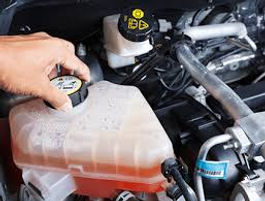
718 Wollard Blvd.
Richmond, MO 64085
816-776-3099
Complete Maintenance Complete Repairs Complete Peace of Mind
Monday - Friday
7:00am - 5:00pm
AUTOMOTIVE TOPICS

Why Correct Coolant Concentration and Winter Flushes Matter More Than You Think
As temperatures start to drop and winter edges closer, most drivers begin thinking about snow tires, battery checks, and maybe a new windshield scraper. But there’s one often-overlooked maintenance item that plays a critical role in your vehicle’s performance and protection during cold weather: your coolant system.
Coolant—also known as antifreeze—isn’t just there to keep your engine from overheating in summer. It also protects it from freezing in winter, lubricates critical components, and helps prevent corrosion inside your radiator and engine. But for it to work effectively, it needs to be at the right concentration and in good condition.
Let’s break down why coolant matters and why you should consider a coolant flush before winter hits.
What Is Coolant, Really?
Coolant is typically a 50/50 mix of antifreeze and distilled water, though the ideal ratio can vary slightly depending on your vehicle and climate. Antifreeze is made of ethylene glycol (or sometimes propylene glycol) and contains corrosion inhibitors, water pump lubricants, and other additives that keep your cooling system healthy.
This mixture does three key things:
-
Regulates Engine Temperature – Prevents overheating in summer and freezing in winter.
-
Prevents Corrosion – Protects metal components like your radiator, water pump, and engine block.
-
Improves Longevity – Keeps your cooling system running efficiently over the long term.
Why Coolant Concentration Matters in Winter?
Too much water in your coolant? It can freeze in extreme cold, expand, and crack your engine block—a catastrophic (and expensive) repair.
Too much antifreeze? It can reduce the fluid’s ability to transfer heat, leading to overheating.
That’s why most vehicles need a proper 50/50 mix (or up to 60/40 in extremely cold climates). A quick test at our shop can confirm if your coolant is within the ideal range—and we’ll adjust it if needed.
What Is a Coolant Flush—and When Do You Need One?
A coolant flush is more than just topping off your coolant. Over time, the additives in antifreeze break down, becoming acidic and losing their ability to prevent rust and corrosion. Old coolant can turn sludgy or contaminated with rust particles, which clog the system and reduce heat transfer.
A proper flush:
-
Completely removes old, degraded coolant
-
Cleans out rust, scale, and debris from the system
-
Replaces it with fresh coolant at the correct concentration
We typically recommend a coolant flush every 30,000–50,000 miles, or every 3–5 years, depending on your vehicle and driving conditions. However, if your coolant looks discolored, smells burnt, or hasn’t been changed in a while, don’t wait—especially before winter.
Signs You Might Need a Coolant Flush
-
Engine is running hotter than usual
-
Heater isn’t blowing warm air
-
Coolant is rusty, sludgy, or smells bad
-
You see a coolant leak or low fluid level
-
It’s been several years since your last service
Don’t Wait for a Breakdown in the Cold
A coolant-related failure in the middle of winter isn’t just inconvenient—it can leave you stranded, without heat, and facing major engine damage. Preventative maintenance like a coolant flush is a simple, affordable way to avoid costly repairs and ensure your vehicle is ready for whatever winter throws your way.
At Complete Auto Service Center, we check your coolant’s condition and freeze point as part of our Winter Readiness Inspection. If it’s time for a flush, we’ll perform a full service using top-quality coolant that meets or exceeds your manufacturer’s specs.
